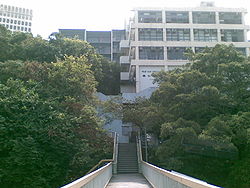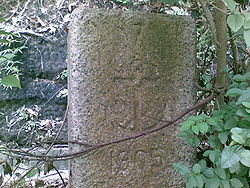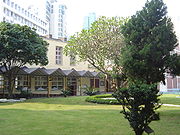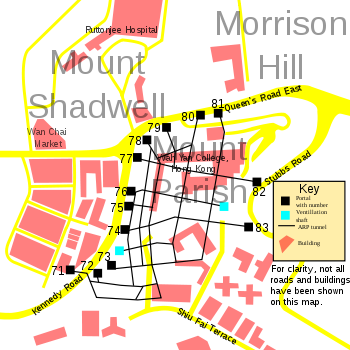
Mount Parish
Encyclopedia

Wan Chai
Wan Chai is a metropolitan area situated at the western part of the Wan Chai District on the northern shore of Hong Kong Island, in Hong Kong. Its other boundaries are Canal Road to the east, Arsenal Street to the west and Bowen Road to the south. The area north of Gloucester Road is often called...
, Hong Kong
Hong Kong
Hong Kong is one of two Special Administrative Regions of the People's Republic of China , the other being Macau. A city-state situated on China's south coast and enclosed by the Pearl River Delta and South China Sea, it is renowned for its expansive skyline and deep natural harbour...
, to the south of Queen's Road East, between Kennedy Road
Kennedy Road, Hong Kong
Kennedy Road is a road in the Mid-levels on the Hong Kong Island, Hong Kong. Starting from Garden Road in the west, it goes past St. Joseph's College, Hong Kong Visual Arts Centre, Hong Kong Park and Hopewell Centre and ends at the junction with Queen's Road East near Morrison Hill in Wan Chai.At...
and Stubbs Road
Stubbs Road
Stubbs Road connects Happy Valley and The Peak area on Hong Kong Island, Hong Kong, through an area near the Wong Nai Chung Gap. It goes through a residential area of luxurious high-rise tower blocks....
.
History

Royal Navy
The Royal Navy is the naval warfare service branch of the British Armed Forces. Founded in the 16th century, it is the oldest service branch and is known as the Senior Service...
bought the Seaman's Hospital in Wan Chai, which was running at a loss, using the money obtained by selling the hospital ship, HMS Melville
HMS Melville (1817)
HMS Melville was a 74-gun third rate ship of the line of the Royal Navy, launched on 17 February 1817 at Bombay Dockyard.From 19 January 1836 until August 1837 she served in North America and the West Indies as the flagship of Vice-Admiral Peter Halkett and was commanded by Captain Peter John Douglas...
. The Seaman's Hospital was renamed the Royal Naval Hospital, and the hill where the hospital stood was named Mount Shadwell, after Vice-Admiral Charles Shadwell
Charles Shadwell (Royal Navy officer)
Admiral Sir Charles Frederick Alexander Shadwell, KCB, FRS was a Royal Navy officer who went on to be Commander-in-Chief, China Station.-Naval career:...
, the Commander-in-Chief on the China Station
China Station
The China Station was a historical formation of the British Royal Navy. It was formally the units and establishments responsible to the Commander-in-Chief, China....
. By 1931 the Infectious Diseases Hospital has been built on the neighbouring hill, which was renamed Mount Parish, after Commodore
Commodore (rank)
Commodore is a military rank used in many navies that is superior to a navy captain, but below a rear admiral. Non-English-speaking nations often use the rank of flotilla admiral or counter admiral as an equivalent .It is often regarded as a one-star rank with a NATO code of OF-6, but is not always...
John E. Parish, the Naval Officer commanding in Hong Kong between 1873 and 1876. A granite pillar at the foot of the hill, beside Queen's Road East, acted as a boundary stone of Royal Navy lands. The pillar is inscribed with a '7', an anchor, and the year '1905'.
After the Second World War
World War II
World War II, or the Second World War , was a global conflict lasting from 1939 to 1945, involving most of the world's nations—including all of the great powers—eventually forming two opposing military alliances: the Allies and the Axis...
started, the Government of Hong Kong
Government of Hong Kong
The Government of the Hong Kong Special Administrative Region of the People's Republic of China, commonly the Hong Kong Government, is led by the Chief Executive as Head of the Government, who is also the head of the Hong Kong SAR...
built a network of air raid protection tunnels in order to prepare for a possible war with the Japanese Army
Imperial Japanese Army
-Foundation:During the Meiji Restoration, the military forces loyal to the Emperor were samurai drawn primarily from the loyalist feudal domains of Satsuma and Chōshū...
. During the Battle of Hong Kong
Battle of Hong Kong
The Battle of Hong Kong took place during the Pacific campaign of World War II. It began on 8 December 1941 and ended on 25 December 1941 with Hong Kong, then a Crown colony, surrendering to the Empire of Japan.-Background:...
, the defenders of Hong Kong fought the Japanese in order to prevent the latter from advancing into Central
Central, Hong Kong
Central is the central business district of Hong Kong. It is located in Central and Western District, on the north shore of Hong Kong Island, across Victoria Harbour from Tsim Sha Tsui, the southernmost point of Kowloon Peninsula...
. The buildings were damaged during the war.
After the war, the Ruttonjee Sanatorium took over the site of the Naval Hospital on Mount Shadwell. In the early 1950s the Infectious Diseases Hospital was demolished in order to make way for a new campus of Wah Yan College, Hong Kong
Wah Yan College, Hong Kong
Wah Yan College, Hong Kong is an eminent grant-in-aid secondary school in Hong Kong. It was founded on 16 December 1919, by Tsui Yan Sau Peter . It is a Roman Catholic secondary school for boys run by the Chinese Province of the Society of Jesus...
, opened in 1955. By 1990 the name of Mount Parish has been dropped off from the map.
Wahyanite campus

The campus of Wah Yan College, Hong Kong
Wah Yan College, Hong Kong
Wah Yan College, Hong Kong is an eminent grant-in-aid secondary school in Hong Kong. It was founded on 16 December 1919, by Tsui Yan Sau Peter . It is a Roman Catholic secondary school for boys run by the Chinese Province of the Society of Jesus...
still stands at the top of the mount, with a size of 20,000 square metres. It was completed and officially opened on 27 September 1955 by the then Governor Sir Alexander Grantham
Alexander Grantham
Sir Alexander William George Herder Grantham, GCMG was a British colonial administrator who governed Hong Kong and Fiji.-Early life, colonial administration career:...
, replacing the old campus at Robinson Road
Robinson Road, Hong Kong
Robinson Road is a 2-lane, bi-directional road on the Mid-levels, Hong Kong Island, Hong Kong. In the east, it is connected with the Magazine Gap Road and Garden Road, and in the west with Babington Road and Park Road, Robinson Road is quite long. With Central-Mid-Levels escalator, it also...
. It was designed by Professor Gordon Brown of the University of Hong Kong, containing classrooms, laboratories, a hall and a chapel.
An extension to the campus was completed in 1987 and named Gordon Wu Hall, after Sir Gordon Wu
Gordon Wu
Sir Gordon Ying Sheung Wu, GBS, KCMG, FICE is the chairman of the board of Hong Kong-listed Asian infrastructure firm Hopewell Holdings Ltd.Born in Hong Kong in 1935, Wu has been an advocate for more than two decades for the construction of Asia's largest bridge project linking Hong Kong, Macau...
, a businessman who was an alumnus of the school. In 1992 a landslide at Mount Parish caused the death of a driver, who was buried alive in his car at Kennedy Road. The landslide prompted the rebuilding of six classrooms, to be reopened in 1998. In 2003 the music room was rebuilt into a six-storey complex. A plan to rebuild the hall is being proposed.
Air raid precaution tunnels


Air-raid shelter
Air-raid shelters, also known as bomb shelters, are structures for the protection of the civil population as well as military personnel against enemy attacks from the air...
(ARP) tunnels under Mount Parish, which was built by the Government some time before the Battle of Hong Kong
Battle of Hong Kong
The Battle of Hong Kong took place during the Pacific campaign of World War II. It began on 8 December 1941 and ended on 25 December 1941 with Hong Kong, then a Crown colony, surrendering to the Empire of Japan.-Background:...
in 1941. Like the other 28 ARP tunnels in Hong Kong, the purpose was to provide protection for citizens from air raids by the Japanese Air Force. The total length of the tunnels is 1.8km, with two ventilation shafts and 13 portals numbered from 71 to 83, along the slope beside Stubbs Road, Queen's Road East and Kennedy Road. Most of the portals were filled in after the war, leaving only three portals which are currently accessible by related government staff, those with numbers 72, 80 and 81. Surveys made in the late 1970s and early 1980s revealed that the tunnels are divided into three levels, with connecting slopes between them.
In the evening of 24 December 1941, Major-General C. M. Maltby warned that the advancing Japanese forces might use the ARP tunnels for infiltration. The next day, which was Christmas Day, his dispatch reported at noon that Japanese artillery opened up at a large scale, and hand to hand fighting was reported by the defence forces on Mount Parish. Soon Mount Parish fell into Japanese hands. The defence forces then fought around Wan Chai Market
Wan Chai Market
The Wan Chai Market was constructed in 1937. It is located at 264 Queen's Road East and Stone Nullah Lane in Wan Chai, Hong Kong Island. It is a Grade III Historic Building....
in an attempt to stop enemy advance into Central
Central, Hong Kong
Central is the central business district of Hong Kong. It is located in Central and Western District, on the north shore of Hong Kong Island, across Victoria Harbour from Tsim Sha Tsui, the southernmost point of Kowloon Peninsula...
, and at one time fired at the ARP tunnel exits using an 18-pounder gun to force the enemies out the tunnels. However within several hours Maltby advised the Governor
Mark Aitchison Young
Sir Mark Aitchison Young, GCMG was a British administrator who became the Governor of Hong Kong during the years immediately before and after the Japanese occupation of the territory.-Early life, service in war:...
that no further military resistance was possible, and the Governor surrendered to the Japanese, ending the Battle.
In the 1960s and 70s, a total of 55 cubic metres of radioactive waste was disposed of inside the ARP tunnels. The waste in the tunnels caused some safety concerns. In 1991, a Government report recommended the transfer of the waste to a special dedicated handling facility. On 19 January 2001 a man was found within the tunnels. He was examined at the scene by health physicists, and no radioactivity was found on his body and clothing. After that the Government built a new radioactive waste storage facility on Siu A Chau
Siu A Chau
Siu A Chau is an uninhabited island of Hong Kong, part of the Soko Islands group, located south of Lantau Island.-Geography:Siu A Chau is the northernmost and the second largest of the Soko Islands, after Tai A Chau. It is dumbbell-shaped and has a rugged indented coastline with steep slopes. The...
, and the waste that used to be in the tunnel was transferred to the new facility in 2005. The new facility was opened officially on 24 June 2006.

